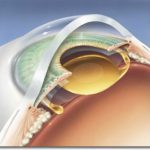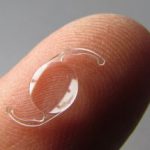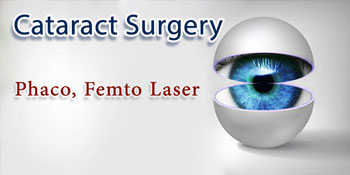Cataract Package (Phacoemulsification: 770$)
Cataract is a common ocular disease whose operation is the most common surgery of the eyes. This disease develops when the eye lens loses its transparency and changes into white or dark color from a light state. In this situation, turbidity prevents development of a clear image in the eyes, and over time with increase in turbidity, the patient loses their vision and require surgery. In the figure, you can see the view of a cloudy and whitened lens in a patient with cataract.
The symptom of the disease is gradual blurring of the vision without pain, redness, or any other discomfort. This disease can be easily diagnosed by an ophthalmologist. In most cases, cataract is not preventable, but protecting the eyes against trauma and damage, early diagnosis and treatment of internal diseases, proper nutrition, protection against environmental factors, and premarital genetic consultation in predisposed families can have a preventive role. Cataract has different reasons, the most important of which is aging. Other reasons include trauma to the eye, internal diseases such as diabetes, metabolic diseases, and infectious diseases. It can even develop in children whose reason is usually congenital and hereditary, but internal and general diseases can also cause cataract in this age group.
Treatment of cataract
The definite cure for cataract is surgery. The surgeon removes the opaque lens and embed an artificial lens instead. The outcome of cataract treatment is very good and effective. In the past, large incisions were used for performing this operation. However, today the surgery can be performed with incisions smaller than 3 mm. There are also special lenses which are flexible and foldable. From the mentioned small incision, these lenses are introduced into the eye, after which they are opened in the eyes and find their main form. To remove the eye lens, a device called “Phaco” is used. This device crushes the lens and through suction it removes the lens from the eyes via ultrasound energy. Thereafter, the foldable artificial lens is embedded in the patient’s eyes and in the place of natural lens. Through this operation, improvement in vision is quick and the patient can restart their routine activities in the early days following operation.
Intraocular lenses
Throughout their development and evolution, these lenses have transformed considerably. Today, these lenses are flexible and although their diameter is around 6 mm, they are introduced into the eye through 3-mm or smaller incisions. The lenses have also improved in terms of quality. In the past, these lenses corrected only the surrounding vision, but recently a type of lenses has been created which can correct both the far and near visions concurrently like the natural eyes of the human.
Lenses have different types. Conventional One-focus lenses are lenses which are used in most people. With these lenses, you will be able to see the far sight well, but for seeing small things nearby such as lines of books, cell phone, writing and similar activities, you will need glasses. Another type of lenses is suitable for those with astigmatism. These lenses are called Toric. This lens is suitable for individuals who have both cataract and astigmatism. Toric lenses help these individuals to be able to see the far sight well, and again they will need glasses for studying and seeing nearby objects. Evidently, for those with astigmatism, if they use typical lenses, they will need glasses following the operation for both the far and near sights. There is a third type of lenses called multi-focal lenses (two-sight, tri-sight). Their aim is to help you see different distances such as close (studying), midrange (computer), and far sights (TV and driving) well. Nevertheless, you can these lenses only if you are always are not astigmatic (fortunately today there are lenses which can correct both the near and far sight as well as astigmatism, but these lenses are expensive and are not suitable for everyone).
In the following figures, from justify to right, you see a sample of typical lens, multifocal lens, stage of incorporation and opening of lens inside the eyes




Preoperative measures :
Before the operation, the ophthalmologist examines your eyes completely, and if necessary, subspecialty consultation is also performed for examining the retina and ocular pressure. Once examinations were completed, the lens number should be measured. Once it was determined, your lens is ordered and prepared. If necessary, other measures such as retina imaging (oct and cornea (topography and specular) are also performed and you receive a time for operation. Again sometimes, you may be required to refer to a retina subspecialist or internal or anesthetic specialist. If you have any special disease such as diabetes, hypertension, or any other diseases, you should inform the treatment team and your ophthalmologist.
According to the opinion of the ophthalmologist, from several days before the surgery, you may be prescribed eye drops to prevent inflammation or infection. In this case, you should use the drugs according to the order. If you use another drug for your disease, inform your ophthalmologist, so that they give you the necessary recommendations on continuing those drugs. Sometimes, you may be required to change your drug regimens especially your anticoagulants, antidiabetic agents, and other drugs.
It is reemphasized that if you have any special disease or use any special medication, inform your ophthalmologist.
Selection of the type of lens :
Concerning selection of the type of lens, the ophthalmologist and treatment team will help you and with the propose the proper lens for you. Therefore, never be worried about it. If your eyes are suitable for toric lenses (astigmatism) or multifocal lenses, they would be suggested to you. Nevertheless, if for any reason such as limited budget, unwillingness or lack of confidence, you did not like to use these lenses and prefer to use typical lenses, there is no worry because after the operation to correct the remaining effects of the eye, you can use glasses. Multifocal lenses may not be suitable for all people and especially those who drive the night for a long time.
Preparation for the operation and day of operation :
Concerning fasting, you should receive the necessary information prior to the surgery from the treatment team or your ophthalmologist. The night before the surgery or on the day of surgery before entering the clinic, you are recommended to bath and clean your face and head completely. On the day of surgery, after going to the reception, complete your file and documents and wait in the preparation sector in order to be transferred to the operation room. Most eye operations including cataract are performed without general anesthesia. However, if general anesthesia has been recommended for you, you should have not consumed any foods or liquids at least eight hours before the surgery. If your operation is performed without complete anesthesia, your eyes are absolutely anesthetized and you will be pain-free and don’t worry about that. During the operation, pay attention to the recommendations and orders of the surgeon and their assists and have the necessary cooperation.
We do our best to facilitate everything so that you have the minimum waiting. Nevertheless, sometimes unfortunately due to the long stages of preparation, patient density in the operation room, or business of the physician and some other unpredicted factors, you may have to wait more than usual. Accordingly, we apologize for that and highly appreciate your patience.
Post operation :
Immediately after the operation, you will be transferred to the recovery room and then to the ward, after which you will be discharged. Before the discharge, your vital signs and general status will be controlled by the nurse of the ward. Nevertheless, if you feel any special problem, inform the nursing staff either through you or your companions.
If at the time of discharge, any drop or drug was given to you, consume them according to the order. Otherwise, the day after the operation and after the first visit by the ophthalmologist, the necessary drops or drugs will be prescribed for you. Continue the drugs according to the order and as long as no order has been given until their command for stopping.
Typically, the day after the surgery, you will be examined by your ophthalmologist or their colleague and you would receive the necessary recommendations. Your vision will improve significantly in the early days following the operation, and you will be able to use your eyes normally. In some cases, given the special situation of your eyes, on the early days, you may have blurred vision, but over time it will improve. If you experienced severe decline in vision or severe abnormal pain within several days after the operation, immediately refer to your ophthalmologist, and if they were not available or the center in which you had been operated was off, refer to one of the emergency centers for the eyes in the city.
Parsian ophthalmology specialty and subspecialty complex has the most up-to-date and complete facilities and the most well-equipped operation rooms. Further, the physicians of this clinic have great experience and skills in performing advanced cataract operations and incorporation of modern intraocular lenses.

